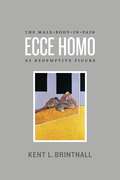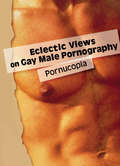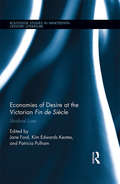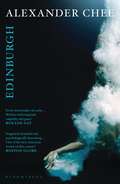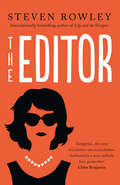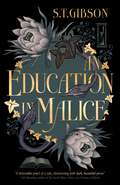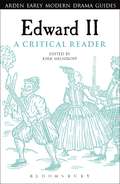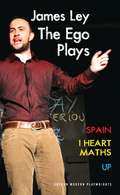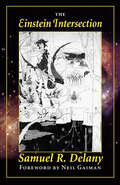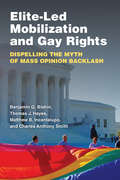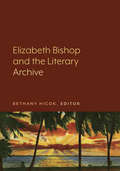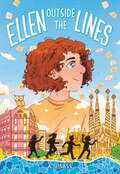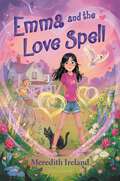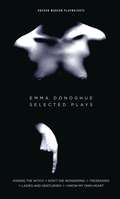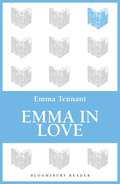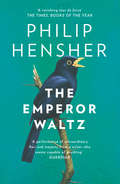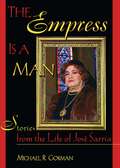- Table View
- List View
Ecce Homo: The Male-Body-in-Pain as Redemptive Figure
by Kent L. BrintnallImages of suffering male bodies permeate Western culture, from Francis Bacon’s paintings and Robert Mapplethorpe’s photographs to the battered heroes of action movies. Drawing on perspectives from a range of disciplines—including religious studies, gender and queer studies, psychoanalysis, art history, and film theory—Ecce Homo explores the complex, ambiguous meanings of the enduring figure of the male-body-in-pain. Acknowledging that representations of men confronting violence and pain can reinforce ideas of manly tenacity, Kent L. Brintnall also argues that they reveal the vulnerability of men’s bodies and open them up to eroticization. Locating the roots of our cultural fascination with male pain in the crucifixion, he analyzes the way narratives of Christ’s death and resurrection both support and subvert cultural fantasies of masculine power and privilege. Through stimulating readings of works by Georges Bataille, Kaja Silverman, and more, Brintnall delineates the redemptive power of representations of male suffering and violence.
Ecce Homo: The Male-Body-in-Pain as Redemptive Figure
by Kent L. BrintnallImages of suffering male bodies permeate Western culture, from Francis Bacon’s paintings and Robert Mapplethorpe’s photographs to the battered heroes of action movies. Drawing on perspectives from a range of disciplines—including religious studies, gender and queer studies, psychoanalysis, art history, and film theory—Ecce Homo explores the complex, ambiguous meanings of the enduring figure of the male-body-in-pain. Acknowledging that representations of men confronting violence and pain can reinforce ideas of manly tenacity, Kent L. Brintnall also argues that they reveal the vulnerability of men’s bodies and open them up to eroticization. Locating the roots of our cultural fascination with male pain in the crucifixion, he analyzes the way narratives of Christ’s death and resurrection both support and subvert cultural fantasies of masculine power and privilege. Through stimulating readings of works by Georges Bataille, Kaja Silverman, and more, Brintnall delineates the redemptive power of representations of male suffering and violence.
Ecce Homo: The Male-Body-in-Pain as Redemptive Figure
by Kent L. BrintnallImages of suffering male bodies permeate Western culture, from Francis Bacon’s paintings and Robert Mapplethorpe’s photographs to the battered heroes of action movies. Drawing on perspectives from a range of disciplines—including religious studies, gender and queer studies, psychoanalysis, art history, and film theory—Ecce Homo explores the complex, ambiguous meanings of the enduring figure of the male-body-in-pain. Acknowledging that representations of men confronting violence and pain can reinforce ideas of manly tenacity, Kent L. Brintnall also argues that they reveal the vulnerability of men’s bodies and open them up to eroticization. Locating the roots of our cultural fascination with male pain in the crucifixion, he analyzes the way narratives of Christ’s death and resurrection both support and subvert cultural fantasies of masculine power and privilege. Through stimulating readings of works by Georges Bataille, Kaja Silverman, and more, Brintnall delineates the redemptive power of representations of male suffering and violence.
Ecce Homo: The Male-Body-in-Pain as Redemptive Figure
by Kent L. BrintnallImages of suffering male bodies permeate Western culture, from Francis Bacon’s paintings and Robert Mapplethorpe’s photographs to the battered heroes of action movies. Drawing on perspectives from a range of disciplines—including religious studies, gender and queer studies, psychoanalysis, art history, and film theory—Ecce Homo explores the complex, ambiguous meanings of the enduring figure of the male-body-in-pain. Acknowledging that representations of men confronting violence and pain can reinforce ideas of manly tenacity, Kent L. Brintnall also argues that they reveal the vulnerability of men’s bodies and open them up to eroticization. Locating the roots of our cultural fascination with male pain in the crucifixion, he analyzes the way narratives of Christ’s death and resurrection both support and subvert cultural fantasies of masculine power and privilege. Through stimulating readings of works by Georges Bataille, Kaja Silverman, and more, Brintnall delineates the redemptive power of representations of male suffering and violence.
Ecce Homo: The Male-Body-in-Pain as Redemptive Figure
by Kent L. BrintnallImages of suffering male bodies permeate Western culture, from Francis Bacon’s paintings and Robert Mapplethorpe’s photographs to the battered heroes of action movies. Drawing on perspectives from a range of disciplines—including religious studies, gender and queer studies, psychoanalysis, art history, and film theory—Ecce Homo explores the complex, ambiguous meanings of the enduring figure of the male-body-in-pain. Acknowledging that representations of men confronting violence and pain can reinforce ideas of manly tenacity, Kent L. Brintnall also argues that they reveal the vulnerability of men’s bodies and open them up to eroticization. Locating the roots of our cultural fascination with male pain in the crucifixion, he analyzes the way narratives of Christ’s death and resurrection both support and subvert cultural fantasies of masculine power and privilege. Through stimulating readings of works by Georges Bataille, Kaja Silverman, and more, Brintnall delineates the redemptive power of representations of male suffering and violence.
Eclectic Views on Gay Male Pornography: Pornucopia
by Todd MorrisonA unique, multifaceted look at the meaning (and the specifics) of gay male pornographyOpen any "gay lifestyle" magazine (even the serious ones) or go to any gay bar, and you&’re likely to encounter something related to pornography, be it an image of a porn "superstar" or advertisements for pornographic magazines, DVDs, calendars, etc. Eclectic Views on Gay Male Pornography Pornucopia examines this phenomenon with a series of provocative essays, in which experts in history, law, media studies, and psychology, as well as laypeople and gay porn insiders explore the complex world of male pornography and the various ways in which it has permeated gay culture-from the 1970s until today.This first-of-its-kind book examines the phenomenon of self-writing and performance for gay men in the last century, specifically looking at the lives of modern-day performance artist Tim Miller, who has received national recognition for his one-man shows portraying his struggles as a gay man; Wakefield Poole (born 1936), the first producer of gay pornography (Bijou, Boys in the Sand) in the era accompanying the emergence of the gay rights movement; gay adult film icon Scott "Spunk" O&’Hara (born 1961); and Aaron Lawrence (born 1971), who worked as a gay escort, actor, and producer/director of his own sexually explicit "amateur" videos.In this groundbreaking analysis of gay men&’s relationship with pornography, you&’ll also learn about: gay pornography and the messages it carries about intimacy, body image, and hegemonic masculinity representations of ethnicity in gay pornography gay pornography and safer sex gay pornography and censorship viewers&’ perceptions of gay pornography gay pornography and internalized homophobia, misogyny, and body fascism changes in the way gay pornography is produced and performed-from the 1970s through the 1990s the meaning of the recurring settings in American gay pornographic videos: prison, the military, and other all-male environments; and recurring themes: leather, S/M, dissatisfaction with heterosexual life, initiation into gay life, etc. In addition, Eclectic Views on Gay Male Pornography presents two fascinating chapters about the case of Little Sisters Book and Art Emporium in Vancouver. In this landmark case, the Canadian Supreme Court was asked to determine whether gay male pornography violated the sex equality protections guaranteed by the Canadian Charter of Rights and Freedoms. The court also examined the way that Canada Customs treats international shipments to gay and lesbian bookstores. In addition, the book provides a revealing insider&’s perspective on the gay adult video industry that contrasts the workaday reality of making porn with the glamorous mythology of the skin trade.
Eclectic Views on Gay Male Pornography: Pornucopia
by Todd MorrisonA unique, multifaceted look at the meaning (and the specifics) of gay male pornographyOpen any "gay lifestyle" magazine (even the serious ones) or go to any gay bar, and you&’re likely to encounter something related to pornography, be it an image of a porn "superstar" or advertisements for pornographic magazines, DVDs, calendars, etc. Eclectic Views on Gay Male Pornography Pornucopia examines this phenomenon with a series of provocative essays, in which experts in history, law, media studies, and psychology, as well as laypeople and gay porn insiders explore the complex world of male pornography and the various ways in which it has permeated gay culture-from the 1970s until today.This first-of-its-kind book examines the phenomenon of self-writing and performance for gay men in the last century, specifically looking at the lives of modern-day performance artist Tim Miller, who has received national recognition for his one-man shows portraying his struggles as a gay man; Wakefield Poole (born 1936), the first producer of gay pornography (Bijou, Boys in the Sand) in the era accompanying the emergence of the gay rights movement; gay adult film icon Scott "Spunk" O&’Hara (born 1961); and Aaron Lawrence (born 1971), who worked as a gay escort, actor, and producer/director of his own sexually explicit "amateur" videos.In this groundbreaking analysis of gay men&’s relationship with pornography, you&’ll also learn about: gay pornography and the messages it carries about intimacy, body image, and hegemonic masculinity representations of ethnicity in gay pornography gay pornography and safer sex gay pornography and censorship viewers&’ perceptions of gay pornography gay pornography and internalized homophobia, misogyny, and body fascism changes in the way gay pornography is produced and performed-from the 1970s through the 1990s the meaning of the recurring settings in American gay pornographic videos: prison, the military, and other all-male environments; and recurring themes: leather, S/M, dissatisfaction with heterosexual life, initiation into gay life, etc. In addition, Eclectic Views on Gay Male Pornography presents two fascinating chapters about the case of Little Sisters Book and Art Emporium in Vancouver. In this landmark case, the Canadian Supreme Court was asked to determine whether gay male pornography violated the sex equality protections guaranteed by the Canadian Charter of Rights and Freedoms. The court also examined the way that Canada Customs treats international shipments to gay and lesbian bookstores. In addition, the book provides a revealing insider&’s perspective on the gay adult video industry that contrasts the workaday reality of making porn with the glamorous mythology of the skin trade.
Economies of Desire at the Victorian Fin de Siècle: Libidinal Lives (Routledge Studies in Nineteenth Century Literature)
by Patricia Pulham Jane Ford Kim Edwards KeatesThis volume marks the first sustained study to interrogate how and why issues of sexuality, desire, and economic processes intersect in the literature and culture of the Victorian fin de siècle. At the end of the nineteenth-century, the move towards new models of economic thought marked the transition from a marketplace centred around the fulfilment of ‘needs’ to one ministering to anything that might, potentially, be desired. This collection considers how the literature of the period meditates on the interaction between economy and desire, doing so with particular reference to the themes of fetishism, homoeroticism, the literary marketplace, social hierarchy, and consumer culture. Drawing on theoretical and conceptual approaches including queer theory, feminist theory, and gift theory, contributors offer original analyses of work by canonical and lesser-known writers, including Oscar Wilde, A.E. Housman, Baron Corvo, Vernon Lee, Michael Field, and Lucas Malet. The collection builds on recent critical developments in fin-de-siècle literature (including major interventions in the areas of Decadence, sexuality, and gender studies) and asks, for instance, how did late nineteenth-century writing schematise the libidinal and somatic dimensions of economic exchange? How might we define the relationship between eroticism and the formal economies of literary production/performance? And what relation exists between advertising/consumer culture and (dissident) sexuality in fin-de-siecle literary discourses? This book marks an important contribution to 19th-Century and Victorian literary studies, and enhances the field of fin-de-siècle studies more generally.
Economies of Desire at the Victorian Fin de Siècle: Libidinal Lives (Routledge Studies in Nineteenth Century Literature)
by Patricia Pulham Jane Ford Kim Edwards KeatesThis volume marks the first sustained study to interrogate how and why issues of sexuality, desire, and economic processes intersect in the literature and culture of the Victorian fin de siècle. At the end of the nineteenth-century, the move towards new models of economic thought marked the transition from a marketplace centred around the fulfilment of ‘needs’ to one ministering to anything that might, potentially, be desired. This collection considers how the literature of the period meditates on the interaction between economy and desire, doing so with particular reference to the themes of fetishism, homoeroticism, the literary marketplace, social hierarchy, and consumer culture. Drawing on theoretical and conceptual approaches including queer theory, feminist theory, and gift theory, contributors offer original analyses of work by canonical and lesser-known writers, including Oscar Wilde, A.E. Housman, Baron Corvo, Vernon Lee, Michael Field, and Lucas Malet. The collection builds on recent critical developments in fin-de-siècle literature (including major interventions in the areas of Decadence, sexuality, and gender studies) and asks, for instance, how did late nineteenth-century writing schematise the libidinal and somatic dimensions of economic exchange? How might we define the relationship between eroticism and the formal economies of literary production/performance? And what relation exists between advertising/consumer culture and (dissident) sexuality in fin-de-siecle literary discourses? This book marks an important contribution to 19th-Century and Victorian literary studies, and enhances the field of fin-de-siècle studies more generally.
Edinburgh
by Alexander Chee'Every word makes me ache … Written with exquisite empathy and grace' Roxane Gay'Singularly beautiful and psychologically harrowing … One of the best American novels of this century' Boston Globe Twelve-year-old Fee is a shy Korean American boy and a newly named section leader of the first sopranos in his local boys' choir. At their summer camp, situated in an idyllic and secluded lakeside retreat, Fee grapples with his complicated feelings towards his best friend, Peter. But as Fee comes to learn how the director treats his section leaders, he is so ashamed he says nothing of the abuse, not even when Peter is in line to be next. When the director is arrested, Fee tries to forgive himself for his silence. Yet the actions of the director have vast consequences, and in their wake, Fee blames only himself. In the years that follow he slowly builds a new life, teaching near his hometown. There, he meets a young student who is the picture of Peter – and is forced to confront the past he believed was gone.
The Editor: A Novel
by Steven Rowley‘Delicately observed’ Sunday Times ‘Laugh-out-loud funny and searingly poignant’ Taylor Jenkins Reid, author of Daisy Jones and the Six
An Education in Malice: the sizzling and addictive dark academia romance everyone is talking about!
by S.T. Gibson'A delectable jewel of a tale, shimmering with dark, beautiful prose' Tori Bovalino, author of The Devil Makes Three, on A Dowry of BloodLove is sacrifice. One of us was always going to bleed for the other.Deep in the forgotten hills of Massachusetts stands Saint Perpetua's College. Isolated and ancient, it is not a place for timid girls. Here, secrets are currency, ambition is lifeblood, and strange ceremonies welcome students into the fold.On her first day of class, Laura Sheridan is thrust into an intense academic rivalry with the beautiful and enigmatic Carmilla. Together, they are drawn into the confidence of their demanding poetry professor, De Lafontaine, who holds her own dark obsession with Carmilla.But as their rivalry blossoms into something far more delicious, Laura must confront her own strange hungers. Tangled in a sinister game of politics, bloodthirsty professors and dark magic, Laura and Carmilla must decide how much they are willing to sacrifice in their ruthless pursuit of knowledge.Sumptuous and addictive, An Education in Malice is a dark academia tale of blood, secrets and insatiable hungers from Sunday Times bestselling author S.T. Gibson, author of the cult hit A Dowry of Blood. Praise for S.T. Gibson:'Stunningly gorgeous and devastatingly romantic, you won't want to miss this one!' Katee Robert, author of Neon Gods, on A Dowry of Blood'An Education in Malice is an ode to girlhood; ribbons, blood, poetry, and rage. Gibson's fang-sharp prose and unflinching honesty create a delicate and fearless exploration of loneliness, love, and-as the bridge between those two absolutes-longing.' Sydney J. Shields, author of The Honey Witch'A thrilling and seductive Gothic rife with spine-tingling tension and dark romance' Alexis Henderson, author of The Year of the Witching, on A Dowry of Blood'Dark, lush and heartrendingly romantic' Lyndall Clipstone, author of Lakesedge, on A Dowry of Blood'An intoxicating perfume that lingers - an undying love story where beauty and horror clasp hands' Rachel Gillig, author of One Dark Window, on A Dowry of Blood'A powerful tale of possession and liberation. . .undeniable and unforgettable' Rose Szabo, author of What Big Teeth, on A Dowry of Blood'A dizzying nightmare of a romance that will leave you aching, angry and ultimately hopeful' Hannah Whitten, author of For the Wolf, on A Dowry of Blood'Atmospheric and lush. . . it will haunt you in the best possible way' Genevieve Gornichec, author of The Witch's Heart, on A Dowry of Blood'A dark seductive tale. . . intermingling love, pain, fear and anger in mesmerizing prose' Publishers Weekly, on A Dowry of Blood'Seductive, lyrical and rich with period detail . . . a dark triumph' Mary McMyne, author of The Book of Gothel, on A Dowry of Blood
Edward II: A Critical Reader (Arden Early Modern Drama Guides)
by Kirk MelnikoffEdward II: A Critical Reader gives students, teachers and scholars alike an overview of the play's reception both in the theatre and among artists and critics, from the end of the 16th century to the beginning of the 21st. The volume also offers a series of new perspectives on the play by leading experts in the field of early modern history and culture. Bolstered with a timeline tracking Marlowe's life and work, an up-to-date bibliography and an extensive index, this collection is an ideal and definitive guide to Edward II.
Edward II: A Critical Reader (Arden Early Modern Drama Guides)
by Kirk MelnikoffEdward II: A Critical Reader gives students, teachers and scholars alike an overview of the play's reception both in the theatre and among artists and critics, from the end of the 16th century to the beginning of the 21st. The volume also offers a series of new perspectives on the play by leading experts in the field of early modern history and culture. Bolstered with a timeline tracking Marlowe's life and work, an up-to-date bibliography and an extensive index, this collection is an ideal and definitive guide to Edward II.
The Ego Plays: Spain, I Heart Maths, Up (Oberon Modern Plays)
by James LeyIncludes the plays Spain, I Heart Maths and UpThe theme of self-indulgence unites the three plays in The Ego Plays collection. At the heart of each is a gay man asking a lot of questions… about himself. These questions range from scientific and philosophical musings to angst-ridden pleas for enlightenment. They come from men who have become so trapped in their own situations that they can no longer successfully connect with the outside world. Up is a play about despair, I Heart Maths is a play about love and Spain is a play about moving on. Together they present the cognitive processes of three men who have allowed personal problems to grow to monstrous proportions. In each of these plays excessive self analysis leads to the main characters taking desperate measures, though frequently also leading to humorous consequences. But while these plays are comedies, exploring the perils of taking oneself too seriously, they are not intended to be cruel. Instead they set their characters free by making their worst fears come true and then taking them somewhere new.
Einstein Intersection
by Samuel R. DelanyThe Einstein Intersection won the Nebula Award for best science fiction novel of 1967. The surface story tells of the problems a member of an alien race, Lo Lobey, has assimilating the mythology of earth, where his kind have settled among the leftover artifacts of humanity. The deeper tale concerns, however, the way those who are "different" must deal with the dominant cultural ideology. The tale follows Lobey's mythic quest for his lost love, Friza. In luminous and hallucinated language, it explores what new myths might emerge from the detritus of the human world as those who are "different" try to seize history and the day.
Elite-Led Mobilization and Gay Rights: Dispelling the Myth of Mass Opinion Backlash
by Benjamin Bishin Matthew Incantalupo Thomas Hayes Charles A SmithMedia and scholastic accounts describe a strong public opinion backlash—a sharply negative and enduring opinion change—against attempts to advance gay rights. Academic research, however, increasingly questions backlash as an explanation for opposition to LGBT rights. Elite-Led Mobilization and Gay Rights argues that what appears to be public opinion backlash against gay rights is more consistent with elite-led mobilization—a strategy used by anti-gay elites, primarily white evangelicals, seeking to prevent the full incorporation of LGBT Americans in the polity in order to achieve political objectives and increase political power. This book defines and tests the theory of Mass Opinion Backlash and develops and tests the theory of Elite-Led Mobilization by employing a series of online and natural experiments, surrounding the U.S. Supreme Court rulings in Obergefell v. Hodges and United States v. Windsor, and President Obama’s position change on gay marriage. To evaluate these theories, the authors employ extensive survey, voting behavior, and campaign finance data, and examine the history of the LGBT movement and its opposition by religious conservatives, from the Lavender Scare to the campaign against Trans Rights in the defeat of Houston’s 2015 HERO ordinance. Their evidence shows that opposition to LGBT rights is a top-down process incited by anti-gay elites rather than a bottom-up reaction described by public opinion backlash.
Elizabeth Bishop and the Literary Archive
by Bethany HicokIn a life full of chaos and travel, Elizabeth Bishop managed to preserve and even partially catalog, a large collection—more than 3,500 pages of drafts of poems and prose, notebooks, memorabilia, artwork, hundreds of letters to major poets and writers, and thousands of books—now housed at Vassar College. Informed by archival theory and practice, as well as a deep appreciation of Bishop’s poetics, the collection charts new territory for teaching and reading American poetry at the intersection of the institutional archive, literary study, the liberal arts college, and the digital humanities. The fifteen essays in this collection use this archive as a subject, and, for the first time, argue for the critical importance of working with and describing original documents in order to understand the relationship between this most archival of poets and her own archive. This collection features a unique set of interdisciplinary scholars, archivists, translators, and poets, who approach the archive collaboratively and from multiple perspectives. The contributions explore remarkable new acquisitions, such as Bishop’s letters to her psychoanalyst, one of the most detailed psychosexual memoirs of any twentieth century poet and the exuberant correspondence with her final partner, Alice Methfessel, an important series of queer love letters of the 20th century. Lever Press’s digital environment allows the contributors to present some of the visual experience of the archive, such as Bishop’s extraordinary “multi-medial” and “multimodal” notebooks, in order to reveal aspects of the poet’s complex composition process.
Ellen Outside the Lines
by A. J. SassWinner of a Sydney Taylor Book Award Honor! A heartfelt novel about a neurodivergent thirteen-year-old navigating changing friendships, a school trip, and expanding horizons for fans of Rain Reign and Ivy Aberdeen's Letter to the World. Thirteen-year-old Ellen Katz feels most comfortable when her life is well planned out and people fit neatly into her predefined categories. She attends temple with Abba and Mom every Friday and Saturday. Ellen only gets crushes on girls, never boys, and she knows she can always rely on her best-and-only friend, Laurel, to help navigate social situations at their private Georgia middle school. Laurel has always made Ellen feel like being autistic is no big deal. But lately, Laurel has started making more friends, and cancelling more weekend plans with Ellen than she keeps. A school trip to Barcelona seems like the perfect place for Ellen to get their friendship back on track. Except it doesn't. Toss in a new nonbinary classmate whose identity has Ellen questioning her very binary way of seeing the world, homesickness, a scavenger hunt-style team project that takes the students through Barcelona to learn about Spanish culture and this trip is anything but what Ellen planned. Making new friends and letting go of old ones is never easy, but Ellen might just find a comfortable new place for herself if she can learn to embrace the fact that life doesn't always stick to a planned itinerary.
Emma and the Love Spell
by Meredith IrelandWitchlings meets The Parent Trap in this contemporary fantasy about a girl who tries to use her fickle witchy powers to keep her best friend (and secret crush!) from moving away.Twelve-year-old, Korean American adoptee Emma Davidson has a problem. Two problems. Okay, three:1. She has a crush on her best friend, Avangeline, that she hasn't been able to share2. Avangeline now has to move out of their town because her parents are getting a divorce3. Oh, and Emma is a secret witch who can't really control her powersIt's a complicated summer between sixth and seventh grade. Emma's parents made her promise that she'd keep her powers a secret and never, ever use them. But if Avangeline's parents fell back in love, it would fix everything. And how hard could one little love spell be?This fast-paced, heartfelt story is a powerful exploration of learning to embrace who you are, even when your true self is different from everyone around you.
Emma Donoghue: Selected Plays (Oberon Modern Playwrights)
by Emma DonoghueKissing the Witch Adapted from her book of thirteen revisionist fairy tales of the same name, this play interweaves four classic plots – Beauty and the Beast, Donkeyskin, the Goose Girl, the Little Mermaid – with an invented one about a desperate girl going to a witch for help. Kissing the Witch finds the gritty in the fantastical, and excavates magic to find what’s really going on. Trespasses Set over three days in 1661, Trespasses is inspired by the judge’s own account of one of the tiny handful of witch trials that ever took place in Ireland. It asks why a servant girl who fell into fits would have put the blame on an old beggarwoman – but also, more timeless questions about the clashing cultures that have to share a small island country. Trespasses is about faith and superstition, politics and class, sadism and love. Ladies and Gentlemen This play with songs, set mostly in the dressing rooms of busy vaudeville theatres all over North America, was inspired by a real same-sex wedding that took place in Grand Rapids, Michigan, in 1886. It resurrects a ragtag troupe of emigrants – most notably, male impersonator Annie Hindle, ‘a man’s widow and a woman’s widower’, as the tabloids called her. With a light touch, Ladies and Gentleman explores the ways we perform our roles, both on and off stage. I Know My Own Heart Inspired by the secret coded diaries of Yorkshire gentlewoman Anne Lister, this play subverts all the conventions of Regency romance. Teasing out the entangled lives of mannish, arrogant Lister (nicknamed ‘Gentleman Jack’) and three of her many lovers, I Know My Own Heart explores the different choices women made in a time of limits and prohibitions. Don’t Die Wondering When a restaurant cook loses her job because of a homophobic customer, she mounts a one-woman picket in protest. The police officer assigned to protect her is her nemesis from schooldays. This one-act comedy, set in a fictional small town, stages a battle between old and new elements of Irish culture.
Emma in Love: Jane Austen's Emma Continued
by Emma TennantTwo years after Emma Woodhouse married Mr Knightley and they have settled into loving, if not quite passionate, matrimony; Emma is bored.To amuse herself, Emma decides to take up matchmaking again, whether her husband will have it or not. But this time Emma is playing for dangerously high stakes. Recently widowed John Knightley, her brother-in-law, is in need of a wife, so when a fascinating French woman enters Highbury society, Emma sees a golden opportunity. Eliza d'Arblay is of French aristocrat whose parents fled the French Revolution. Beautiful, intriguing and romantic, Emma deems her to be the perfect match for John. But as Eliza charms Highbury society, John isn't the only one who falls deeply in love with her...a passion awakes in Emma that she never would have expected.
The Emperor Waltz
by Philip HensherThe most ambitious and daring novel novel yet from Booker Prize-shortlisted Philip Hensher. ‘A novel that's almost fizzy to the touch … A performance of extraordinary flair and majesty from a writer who seems capable of anything’ Guardian
The Empress Is a Man: Stories from the Life of José Sarria
by Michael R GormanYou may be familiar with the tremendous life achievements of José Sarria, an integral player in the gay rights movement, but never before have you heard the intimate details of his incredible life as they are portrayed here. In The Empress Is a Man: Stories from the Life of José Sarria (winner of the Lammy Award in the transgender category), Michael Gorman exposes Sarria’s life in a frank manner and with a unique storytelling ability that simultaneously causes amusement and sadness. Sarria’s amazing life story tells of his perserverance to advance the cause of equality for gay citizens.At a time when gays were arrested, institutionalized, and castrated, Sarria did not try to hide his beliefs and convictions. Sarria was ahead of his time, becoming a significant figure in gay history and culture. You’ll find The Empress Is a Man fascinating as you read about the life of this truly courageous, outrageous, and remarkable man. Some of Sarria’s experiences and achievements you’ll read about include: being the first openly gay male to run for political office being one of America’s most important female impersonators entertaining throughout the world, live and on film postitively affecting the gay community founding an extremely successful charity fundraising organization being featured in a PBS documentary serving in the Army in The Battle of the Bulge in WWIIUntil recently, gay and lesbian stories were published in very limited venues and often at great personal risk, forcing knowledge of this history to be passed down orally. The Empress Is a Man reflects this tradition by telling much of the story in Sarria’s own words. Adding to the enjoyment and originality of this book is a structure similar to the dramatic style of a play or novel. Each section ends with an exciting climax, although the book is chronological in order. The Empress Is a Man is an untraditional book about an untraditional man.
The Empress Is a Man: Stories from the Life of José Sarria
by Michael R GormanYou may be familiar with the tremendous life achievements of José Sarria, an integral player in the gay rights movement, but never before have you heard the intimate details of his incredible life as they are portrayed here. In The Empress Is a Man: Stories from the Life of José Sarria (winner of the Lammy Award in the transgender category), Michael Gorman exposes Sarria’s life in a frank manner and with a unique storytelling ability that simultaneously causes amusement and sadness. Sarria’s amazing life story tells of his perserverance to advance the cause of equality for gay citizens.At a time when gays were arrested, institutionalized, and castrated, Sarria did not try to hide his beliefs and convictions. Sarria was ahead of his time, becoming a significant figure in gay history and culture. You’ll find The Empress Is a Man fascinating as you read about the life of this truly courageous, outrageous, and remarkable man. Some of Sarria’s experiences and achievements you’ll read about include: being the first openly gay male to run for political office being one of America’s most important female impersonators entertaining throughout the world, live and on film postitively affecting the gay community founding an extremely successful charity fundraising organization being featured in a PBS documentary serving in the Army in The Battle of the Bulge in WWIIUntil recently, gay and lesbian stories were published in very limited venues and often at great personal risk, forcing knowledge of this history to be passed down orally. The Empress Is a Man reflects this tradition by telling much of the story in Sarria’s own words. Adding to the enjoyment and originality of this book is a structure similar to the dramatic style of a play or novel. Each section ends with an exciting climax, although the book is chronological in order. The Empress Is a Man is an untraditional book about an untraditional man.
